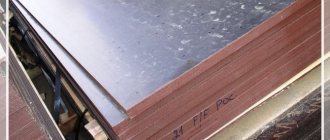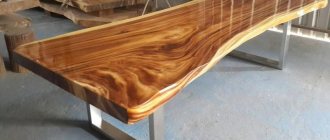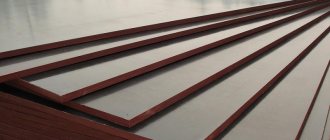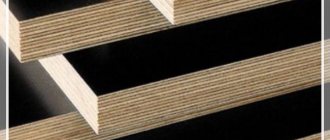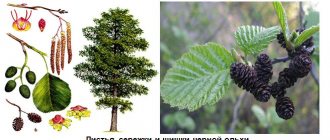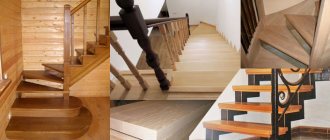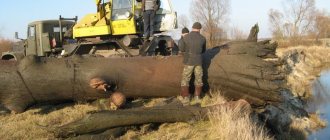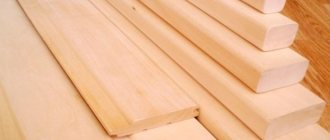We tell you everything about plywood from A to Z.
What is plywood? Plywood is a versatile material that is used for various purposes almost everywhere. Externally, plywood looks like rectangular sheets of certain sizes of varying thickness, consisting of many layers (at least 3) of wood fiber raw materials. Plywood can be made from wood or tree veneer.
Most often, plywood is made from wood veneer, the layers of which are laid perpendicular to each other and glued with special compounds. This manufacturing technology provides excellent strength and wear resistance, and also increases the material’s ability to resist moisture penetration.
Types of plywood
There are many types of plywood available; it can be moisture-resistant, laminated, made from different types and types of wood, and also have different thicknesses and purposes. How do you determine the type of plywood based on the material? In this case, attention is paid only to the outer layer of plywood, without taking into account the internal ones.
Depending on the type of feedstock, the following types are distinguished:
- birch plywood;
- softwood plywood;
- combined plywood.
Birch plywood is plywood that is made from veneer of hardwood (birch). Birch veneer has a uniform, more uniform structure and good density (about 650 kg/m3). Birch veneer plywood is much stronger than its counterparts made from other materials. The difference in strength sometimes reaches 20%.
However, the cost of birch plywood is slightly higher than that of its analogues. This is explained by the lack of natural resins in birch veneer, which means additional compounds are required to create good quality plywood. The use of birch plywood is quite widespread. It is used in the construction of private houses, for packaging transported goods, ship and carriage building, as well as in many areas of the automotive industry.
Coniferous plywood (photo below) is cheaper than birch plywood. In Russia, coniferous plywood is usually made from pine and spruce bark. This plywood is lighter and has an interesting appearance due to the wood pattern. However, coniferous plywood is less durable than birch plywood. Coniferous veneer contains natural resin, which contributes to longer service life of the material.
Natural resins protect plywood from dampness and rotting. Coniferous plywood is in greatest demand in individual housing construction, as well as in the field of interior design and the creation of decorative elements.
Which is better - coniferous or birch plywood? Birch plywood is stronger, while coniferous plywood is cheaper and has better environmental resistance due to natural resins. These are two different types of plywood that are difficult to compare - where one does not fit, the other will - and vice versa.
The next type of plywood is combined .
This material consists of both birch and coniferous wood fibers. It combines the advantages of birch and coniferous plywood. Combined plywood is similar in strength and technical characteristics to birch plywood, however, its price is slightly lower. Combined plywood is widely used in construction, furniture production and packaging.
Resistance to aggressive environments
Requirements for FSF certification of plywood.
This material has excellent endurance. It is not at all afraid of dilute acids; acidic salts cannot cope with it. Alkalis can help soften the material. Bad effect on plywood:
- chlorine;
- hypochlorites;
- nitrates.
It is best to avoid direct contact with these materials. Loss of strength and swelling can be caused by organic liquids such as alcohol. Oils of petroleum origin do not have any effect; their effect is reflected in the loss of color. To increase the chemical resistance of sheets, phenolic films are used and the surface is lined with fiberglass plastic.
FSF plywood is used when performing finishing work. Its components are quite toxic, which makes it impossible to use this material inside a building. Birch sheets have the best technical performance. They have the following advantages:
- high strength;
- excellent quality;
- wear resistance;
- environmental friendliness;
- aesthetic appearance.
This brand is quite accessible for different directions. It is used in:
Plywood technical characteristics table.
- furniture production;
- transport;
- shipbuilding;
- packaging production;
- monolithic construction;
- finishing of buildings;
- roofing works;
- mechanical engineering.
Due to excellent technical data, moisture-resistant plywood is placed under the flooring. Having excellent environmental friendliness and a long service life, FSF plywood can be used to decorate the walls and partitions of a children's room, and children's structures can be made from it.
Types of plywood by adhesive composition
The next aspect by which plywood is divided is the type of composition used for gluing the layer.
Depending on the adhesive composition, plywood can be:
FBA plywood is plywood that is produced using albumin casein glue. FBA plywood is an environmentally friendly material and is not waterproof. This plywood can be used for any purpose at low humidity levels. For example, environmentally friendly FBA plywood can be used in the production of children's toys, furniture, etc.
FC plywood. What is FC plywood? FK type plywood is produced with a urea adhesive composition. Plywood has low moisture resistance. The raw materials of FC plywood do not emit harmful substances, the material is absolutely environmentally friendly, so it can be used for interior work in residential premises and children's institutions.
FKM plywood. In the production process of this type of plywood, melamine glue is used. FKM plywood has average moisture resistance. The adhesive composition contains a small amount of harmful substances. FKM plywood can be used in conditions of low humidity levels and where there are no strict restrictions on the toxicity of materials.
FSF plywood. FSF type plywood has excellent moisture resistance properties. However, in its production a phenol-formaldehyde adhesive composition is used, which contains a fairly large amount of harmful substances. The use of FSF plywood grades in residential premises, as well as for furniture production, is highly discouraged due to the high risk of harm to human health.
Bakelite plywood. This type of plywood is produced by impregnating veneer sheets with bakelite glue. FB plywood has excellent moisture resistance and is also able to “work” under conditions of exposure to aggressive environments. This plywood can be used in difficult climatic conditions (at low or high temperatures); it perfectly withstands the effects of sea water, various microorganisms, acids and alkalis. In turn, bakelite plywood is divided depending on the composition of the resins (FBS, FBV) and the type of sizing.
FBS bakelite plywood is impregnated with alcohol-soluble adhesives, has high moisture resistance and comes in the following types:
- FBS bakelite plywood is the highest quality class of this material due to the impregnation of all layers with bakelite alcohol-soluble glue;
- FBS1 plywood is of slightly worse quality. The production technology of this plywood involves coating, rather than impregnation, of veneer layers;
- class FBS1A has the lowest quality among bakelite plywood with alcohol-soluble adhesives. Here, only the longitudinally located layers of veneer are coated with an adhesive composition.
The next subtype of bakelite plywood is FBV , made with water-soluble adhesives. FBV plywood comes in two types: FBV (where the inner layers of veneer are coated, and the outer layers are impregnated with adhesives) and FBV1 (where all veneer layers are only coated with adhesives). The main advantage of such plywood is its excellent strength characteristics.
Types of plywood by processing method
The next criterion for grouping plywood is the surface treatment method.
According to the surface texture of plywood, there are:
- Laminated plywood. To do this, plywood is covered with special waterproof films. Laminated plywood is widely used for trim and upholstery of vans.
- Polished on one side.
- Polished on both sides.
- Unpolished.
On the portal stroyka.ru you can buy any types of plywood, as well as see photos of samples and compare prices from suppliers.
Classification of plywood by purpose
The scope of application of plywood (laminated, sanded, moisture-resistant and other types) is not limited to construction; due to its properties, the material is extremely in demand in various fields.
The stroyka.ru portal offers the following classification of plywood by purpose:
Marine flame retardant plywood. For the finishing of shipping vessels, only the highest quality types and grades of moisture-resistant FB plywood (on bakelite glue) are used, which work well in conditions of high humidity and aggressive environments.
Furniture. The types of plywood used for furniture must be environmentally friendly, wear-resistant and durable. As a rule, combined FC plywood is used for furniture.
Construction In the construction industry, as a rule, grades 3/4 and 4/4 birch plywood are used. These types of plywood can be used for floors, walls and other structures as a rough finish.
Aviation. For these purposes, FSF grades of plywood are used. This plywood has excellent technical characteristics and is ideal for such complex and critical areas of activity as aircraft, ship, railcar and automotive industries.
Formwork. To create the formwork, laminated FB plywood is used, which has excellent characteristics in terms of moisture and wear resistance, strength and exposure to aggressive environments.
Decorative. FC plywood is used for finishing the premises. This type of plywood must have excellent characteristics of the outer layer (flat surface with a textured pattern). This type of plywood is usually made from valuable wood or premium wood.
Automotive. For cars, as a rule, FSF type plywood with a laminated or mesh-ribbed surface is used. Plywood has high strength, moisture resistance and durability. It is used for covering all elements of a truck body (walls, floor, doors, ceiling).
Industrial Applications
The many advantages of this material (especially its high strength) lead to its widespread use.
Construction
Despite the fact that the price of the material is relatively high, it is used in construction work:
- in the manufacture of monolithic structures;
- as well as when arranging floors;
- when covering walls with your own hands in private construction (see also the article Finishing walls with plywood - beautiful, practical and durable).
That is, where high-strength material is required.
Plywood sheets laid on a concrete floor
Note! Plywood copes well with high loads.
There are often cases when the beautiful texture and warm tone of the surface are appreciated by fashion designers, using birch plywood as a material for interior decoration and production. After all, such wood has the lightest shade of all existing ones.
Mechanical engineering
Due to its lightness and strength, birch plywood is often used in transport engineering:
- floors and walls in passenger and commercial vehicles are made of birch plywood;
- to arrange the floors of trucks, laminated plywood is used - in this case, birch is inserted to form a mesh covering (see also the article Covering the body with plywood - this is not at all difficult);
- in rooms with high levels of moisture, as the instructions provide, FSF is used.
Car floor made of birch plywood
Aircraft industry
Aviation plywood is used in aircraft construction, as its name itself suggests. Engineers and aircraft designers value the material for its high strength and density.
Coniferous wood will not be appropriate in this case, since veneer created from such wood will not be highly durable. This type of birch plywood is made from high-quality veneers by gluing individual sheets with phenolic adhesives.
Aviation type of plywood
Note! High quality control of finished products is of great importance in this process, because it will affect the performance characteristics of the entire aircraft.
Plywood: assortment, characteristics
Currently, plywood is produced in five grades. The technical characteristics of each type of plywood are strictly defined in the current GOST.
Plywood varieties:
Grade 4. This grade of plywood is the cheapest and lowest quality. Grade 4 plywood sheets may have multiple wormholes, uniformity defects (fallen knots) and uneven sheet edges (depressions up to 0.5 mm). This type of plywood is used for interior rough finishing. The most common area of application for this type of plywood is the production of various packaging and packaging.
Grade 3. Grade 3 plywood can also have wormholes, but in strictly limited quantities (no more than 10 pcs/sq.m.). The size of wormholes is also limited (the diameter should not exceed 6 mm), and the number of all defects on a sheet of plywood should be less than 9. Grade 3 plywood is also used for rough finishing of premises. However, it is permissible to use this type of plywood in fine finishing work, provided that paint and varnish compounds are applied to the surface of the sheets to hide defects in the material.
Grade 2. Plywood may have the following defects: cracks no more than 20 cm, areas with leaked glue (if the area of the area is up to 2% of the total square footage of the sheet), wood inserts. This plywood, like grade 3, is used for rough and fine finishing for painting.
Grade 1. Defects allowed on grade 1 plywood are cracks and warping less than 2 cm in length. Grade 1 plywood is used in construction for finishing indoors and outdoors.
Grade E. Plywood E belongs to the elite grade. Grade E plywood must clearly comply with the characteristics stated in GOST, namely: not have wormholes, cracks or other defects, except for random deformations in the structure of the wood itself. Elite grade plywood is the highest quality and most expensive. Used for fine finishing.
offers a wide selection of bakelite, laminated, flame retardant, FK, FSF, birch, coniferous and other types of plywood at affordable prices with delivery throughout Russia. Sale of plywood from 1 sheet to wholesale. At your service - cutting and cutting plywood using modern CNC equipment.
Dimensions and thickness
Such products are manufactured and sold in the form of rectangular sheets of standard sizes. Regular sheets have sizes: 1220x1220, 1525x1220 or 1525x1525. Large format options are also used: 1830x1525, 2440x1220, 2500x1250, 3000x1500 or 3050x1525.
Sheets vary in thickness. This characteristic is determined by how many layers are used. For plywood thickness, GOST sets minimum and maximum values. They are 3 and 30 mm.
Plywood comes in the following types:
- Thin plywood thinner than 3 mm is called aviation grade. In the past it was in demand in the aircraft industry. Now it has found application in aviation modeling. It can bend easily, which allows you to make original products.
- When the thickness of plywood is 5 mm, it is used to create furniture and decorate walls in rooms. This type has the widest popularity.
- When a 6mm layer is used, this means that a five-layer construction is being considered. It is suitable for decorating rooms.
- At 10 mm thickness it contains 7 layers of veneer. Furniture can be made from it. This material is suitable for finishing work.
- When the plywood thickness is 12-16 mm or more, then such sheets are called slabs. They contain 9 or more layers of wood. Used for installing shelving, arranging partitions between rooms, and flooring.
There are slabs that are thicker. They are used in construction.
